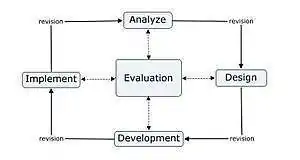Introduction to ADDIE
For the purpose of developing efficient training programs, educators and training specialists frequently use the ADDIE paradigm compared to other Instructional Designing methods such as the Kirk-Patrick method, SAM, Kemp Design model, etc. Analysis, Design, Development, Implementation, and Evaluation are referred to as ADDIE. Since its initial introduction in the 1970s, the paradigm has been utilized by training specialists. We will go over each stage analyze design development implementation and evaluation of this model and how it can be applied to creating efficient instructional goals in this piece.

Analysis Phase
The analysis is the first stage of the ADDIE paradigm. The training specialist determines the organization’s and the target audience’s training requirements during this phase. This entails assessing the audience’s abilities and information, spotting performance gaps, and figuring out what the training program should accomplish. Conducting a needs assessment, a procedure for gathering information to determine the organization’s training needs may also be part of the analysis step.

Design Phase
Design is the second stage of this paradigm. The training specialist creates a training program blueprint during this period. This entails defining the learning goals, creating the training resources, and selecting the instructional techniques to be applied. The training specialist also creates the assessment tools that will be used to gauge the success of the training program during the design process.
Development Phase
Development is the ADDIE model’s final phase. The training specialist develops the real training materials during this stage, including slide decks, handouts, and e-learning modules. Testing the training materials during the development stage ensures that they are efficient and meet the learning goals.
Implementation Phase
Implementation is the ADDIE model’s fourth step. The intended audience is presented with the training program during this period. The training may be delivered in person or online during the execution phase and may utilize a variety of instructional techniques.

Evaluation Phase
Evaluation is the ADDIE model’s last stage. The training specialist evaluates the training program’s efficacy during this stage. Analyzing the outcomes of the assessment tools that were created during the design process and getting audience input are two examples of this. It is determined whether the training program was successful in achieving the intended learning outcomes during the evaluation phase.
Advantages
- Flexible and efficient
- A flexible and efficient instrument for creating training programs is the ADDIE model. Since it can be applied in many different situations and sectors, training specialists frequently choose it.
- A comprehensive training course that takes audience and organization requirements into account
- The ADDIE model ensures that the training program addresses the needs of both the audience and the organization. This comprehensive approach helps to ensure that the training program is relevant and effective.
- Consistent and organized training curriculum delivery
- The ADDIE model provides a systematic and consistent approach to delivering training programs. This helps to ensure that the audience understands and learns the material. It helps in creating a continuous improvement method to a learning objective and targeted approach to the entire learning environment.
- A cyclical procedure enables ongoing development over time
- The ADDIE model is a cyclical process, which means that the training program can be evaluated and improved over time. This helps to ensure that the training program remains relevant and effective.
- Can be used in a variety of sectors and training programs.
- The ADDIE model can be used for different types of training, including in-person training, e-learning, and blended learning. It can also be applied to different industries, making it a versatile tool for training professionals.
Disadvantages
- Time-consuming and expensive to implement
- The ADDIE model requires a lot of planning and development, which can be time-consuming and expensive. This can be a barrier for some organizations that have limited resources.
- The linear process may be problematic if changes are needed during the implementation
- The ADDIE model is a linear process, which means that each phase must be completed before moving on to the next phase. This can be problematic if changes need to be made during the implementation phase.
- A rigid and inflexible approach may not be suitable for all training contexts
- The ADDIE model provides a framework for creating a training program, but it may not be suitable for all training contexts. In some cases, training professionals may need to use a more flexible approach that allows for more experimentation and adaptation.

How to implement the ADDIE method using tools and software?
When applying this model, using software tools like Trello, Asana, or Microsoft Project might be useful because they offer a digital platform for managing the many phases of the project. Here are some applications for each of these tools:
Trello: Trello is a tool for managing projects visually. It employs boards, lists, and cards to group and rank tasks. Using lists and cards, you may track progress, assign tasks, and engage with team members on a board for each step of the ADDIE model. Create a board for the analysis phase, for instance, with lists for the various activities like “Gather Data,” “Analyse Data,” and “Create Report.” Then you may make cards for every assignment, assign them to team members, specify due dates, and include comments and attachments.
Asana: Asana is a project management program that enables you to make tasks, distribute them to team members, and monitor their development. The ADDIE paradigm can be managed using Asana by establishing a project and segmenting it into tasks for each step. The Asana dashboard may then be used to assign tasks to team members, establish due dates, and monitor progress. Asana enables team collaboration by allowing you to add comments, attachments, and tags to documents.
Microsoft Projects: You may develop project plans, schedules, and timeframes with Microsoft Project, a tool for project management. The ADDIE paradigm can be managed using Microsoft Project by developing a project plan for each phase and decomposing it into tasks and subtasks. The Gantt chart view can then be used to assign resources, create deadlines, and monitor progress. Microsoft Project also allows for the sharing of the project schedule and work delegation with team members.
Conclusion
In conclusion, the ADDIE model is a tested and real instructional design method that can be applied to develop skills training courses. Training experts can ensure that their training programs are effective according to the five stages of the ADDIE model and the needs of both the organization and the potential audience. Due to its ability to adapt to different training contexts and audiences, the ADDIE model is a useful tool for educators and training experts.

![The Power of Storytelling in Corporate Training: Igniting Success and Inspiring Growth [2023]](https://trainercentric.com/wp-content/uploads/2023/06/storytelling-1024x576.jpg)

